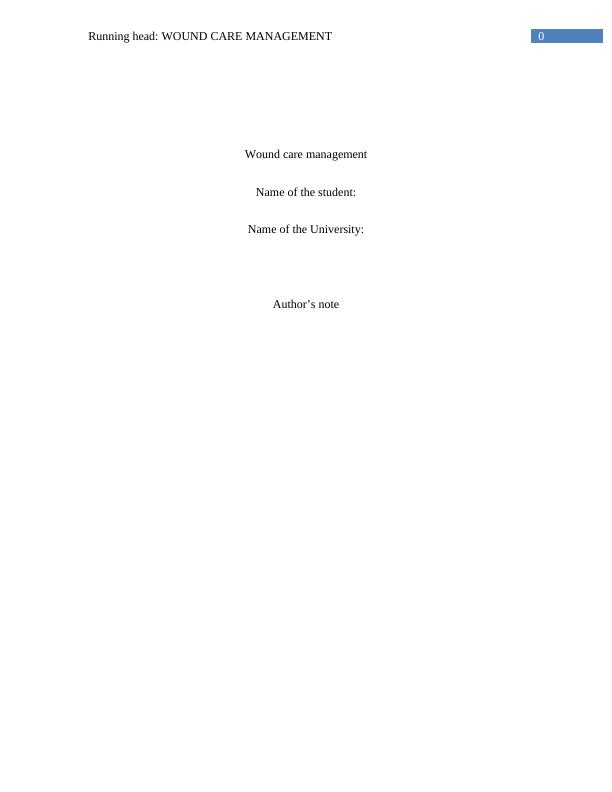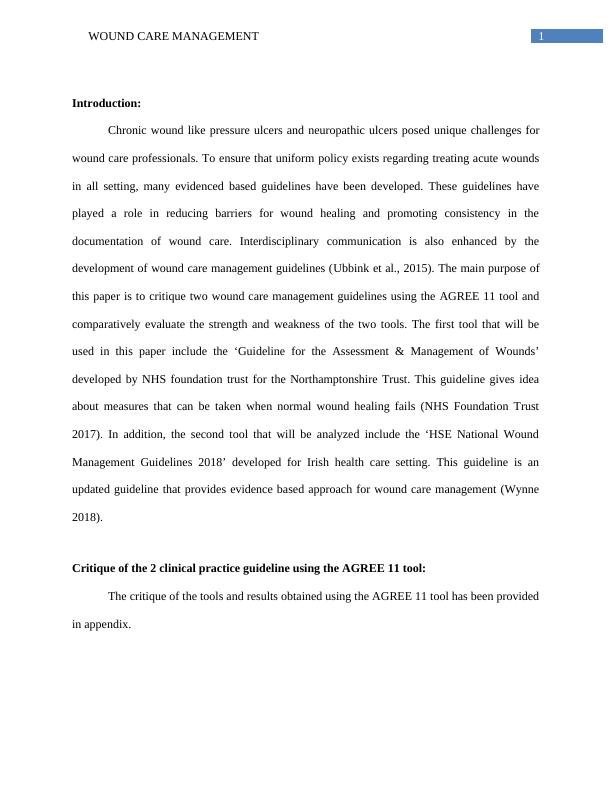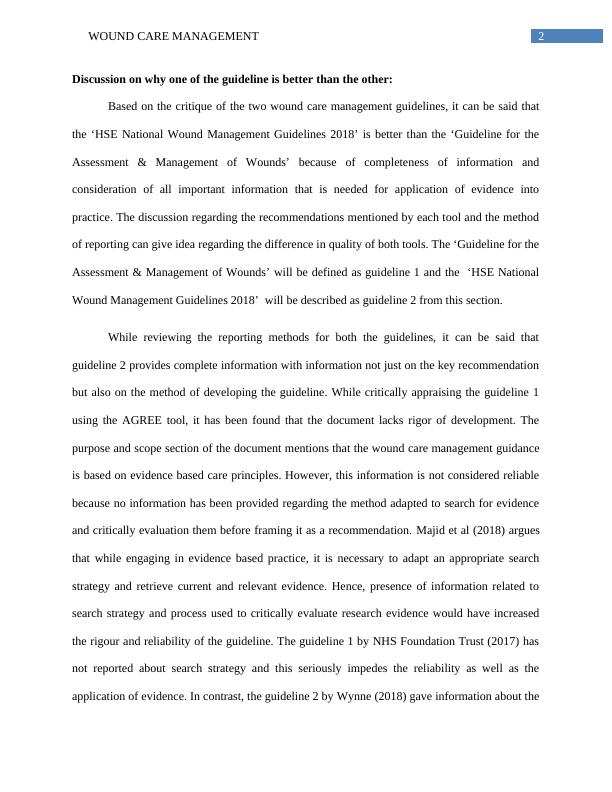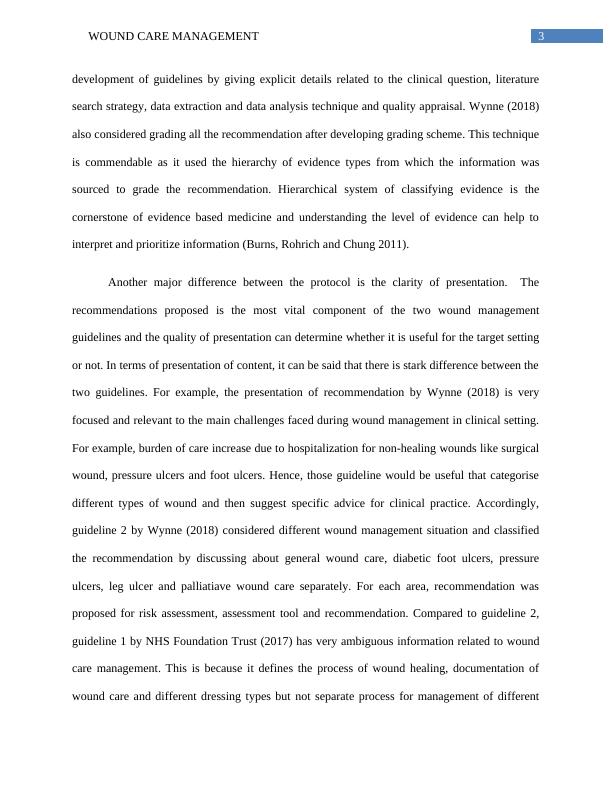Wound Care Management: A Comparative Evaluation of Two Guidelines
Added on 2023-06-03
17 Pages3928 Words314 Views
0Running head: WOUND CARE MANAGEMENT
Wound care management
Name of the student:
Name of the University:
Author’s note
Wound care management
Name of the student:
Name of the University:
Author’s note

1WOUND CARE MANAGEMENT
Introduction:
Chronic wound like pressure ulcers and neuropathic ulcers posed unique challenges for
wound care professionals. To ensure that uniform policy exists regarding treating acute wounds
in all setting, many evidenced based guidelines have been developed. These guidelines have
played a role in reducing barriers for wound healing and promoting consistency in the
documentation of wound care. Interdisciplinary communication is also enhanced by the
development of wound care management guidelines (Ubbink et al., 2015). The main purpose of
this paper is to critique two wound care management guidelines using the AGREE 11 tool and
comparatively evaluate the strength and weakness of the two tools. The first tool that will be
used in this paper include the ‘Guideline for the Assessment & Management of Wounds’
developed by NHS foundation trust for the Northamptonshire Trust. This guideline gives idea
about measures that can be taken when normal wound healing fails (NHS Foundation Trust
2017). In addition, the second tool that will be analyzed include the ‘HSE National Wound
Management Guidelines 2018’ developed for Irish health care setting. This guideline is an
updated guideline that provides evidence based approach for wound care management (Wynne
2018).
Critique of the 2 clinical practice guideline using the AGREE 11 tool:
The critique of the tools and results obtained using the AGREE 11 tool has been provided
in appendix.
Introduction:
Chronic wound like pressure ulcers and neuropathic ulcers posed unique challenges for
wound care professionals. To ensure that uniform policy exists regarding treating acute wounds
in all setting, many evidenced based guidelines have been developed. These guidelines have
played a role in reducing barriers for wound healing and promoting consistency in the
documentation of wound care. Interdisciplinary communication is also enhanced by the
development of wound care management guidelines (Ubbink et al., 2015). The main purpose of
this paper is to critique two wound care management guidelines using the AGREE 11 tool and
comparatively evaluate the strength and weakness of the two tools. The first tool that will be
used in this paper include the ‘Guideline for the Assessment & Management of Wounds’
developed by NHS foundation trust for the Northamptonshire Trust. This guideline gives idea
about measures that can be taken when normal wound healing fails (NHS Foundation Trust
2017). In addition, the second tool that will be analyzed include the ‘HSE National Wound
Management Guidelines 2018’ developed for Irish health care setting. This guideline is an
updated guideline that provides evidence based approach for wound care management (Wynne
2018).
Critique of the 2 clinical practice guideline using the AGREE 11 tool:
The critique of the tools and results obtained using the AGREE 11 tool has been provided
in appendix.

2WOUND CARE MANAGEMENT
Discussion on why one of the guideline is better than the other:
Based on the critique of the two wound care management guidelines, it can be said that
the ‘HSE National Wound Management Guidelines 2018’ is better than the ‘Guideline for the
Assessment & Management of Wounds’ because of completeness of information and
consideration of all important information that is needed for application of evidence into
practice. The discussion regarding the recommendations mentioned by each tool and the method
of reporting can give idea regarding the difference in quality of both tools. The ‘Guideline for the
Assessment & Management of Wounds’ will be defined as guideline 1 and the ‘HSE National
Wound Management Guidelines 2018’ will be described as guideline 2 from this section.
While reviewing the reporting methods for both the guidelines, it can be said that
guideline 2 provides complete information with information not just on the key recommendation
but also on the method of developing the guideline. While critically appraising the guideline 1
using the AGREE tool, it has been found that the document lacks rigor of development. The
purpose and scope section of the document mentions that the wound care management guidance
is based on evidence based care principles. However, this information is not considered reliable
because no information has been provided regarding the method adapted to search for evidence
and critically evaluation them before framing it as a recommendation. Majid et al (2018) argues
that while engaging in evidence based practice, it is necessary to adapt an appropriate search
strategy and retrieve current and relevant evidence. Hence, presence of information related to
search strategy and process used to critically evaluate research evidence would have increased
the rigour and reliability of the guideline. The guideline 1 by NHS Foundation Trust (2017) has
not reported about search strategy and this seriously impedes the reliability as well as the
application of evidence. In contrast, the guideline 2 by Wynne (2018) gave information about the
Discussion on why one of the guideline is better than the other:
Based on the critique of the two wound care management guidelines, it can be said that
the ‘HSE National Wound Management Guidelines 2018’ is better than the ‘Guideline for the
Assessment & Management of Wounds’ because of completeness of information and
consideration of all important information that is needed for application of evidence into
practice. The discussion regarding the recommendations mentioned by each tool and the method
of reporting can give idea regarding the difference in quality of both tools. The ‘Guideline for the
Assessment & Management of Wounds’ will be defined as guideline 1 and the ‘HSE National
Wound Management Guidelines 2018’ will be described as guideline 2 from this section.
While reviewing the reporting methods for both the guidelines, it can be said that
guideline 2 provides complete information with information not just on the key recommendation
but also on the method of developing the guideline. While critically appraising the guideline 1
using the AGREE tool, it has been found that the document lacks rigor of development. The
purpose and scope section of the document mentions that the wound care management guidance
is based on evidence based care principles. However, this information is not considered reliable
because no information has been provided regarding the method adapted to search for evidence
and critically evaluation them before framing it as a recommendation. Majid et al (2018) argues
that while engaging in evidence based practice, it is necessary to adapt an appropriate search
strategy and retrieve current and relevant evidence. Hence, presence of information related to
search strategy and process used to critically evaluate research evidence would have increased
the rigour and reliability of the guideline. The guideline 1 by NHS Foundation Trust (2017) has
not reported about search strategy and this seriously impedes the reliability as well as the
application of evidence. In contrast, the guideline 2 by Wynne (2018) gave information about the

3WOUND CARE MANAGEMENT
development of guidelines by giving explicit details related to the clinical question, literature
search strategy, data extraction and data analysis technique and quality appraisal. Wynne (2018)
also considered grading all the recommendation after developing grading scheme. This technique
is commendable as it used the hierarchy of evidence types from which the information was
sourced to grade the recommendation. Hierarchical system of classifying evidence is the
cornerstone of evidence based medicine and understanding the level of evidence can help to
interpret and prioritize information (Burns, Rohrich and Chung 2011).
Another major difference between the protocol is the clarity of presentation. The
recommendations proposed is the most vital component of the two wound management
guidelines and the quality of presentation can determine whether it is useful for the target setting
or not. In terms of presentation of content, it can be said that there is stark difference between the
two guidelines. For example, the presentation of recommendation by Wynne (2018) is very
focused and relevant to the main challenges faced during wound management in clinical setting.
For example, burden of care increase due to hospitalization for non-healing wounds like surgical
wound, pressure ulcers and foot ulcers. Hence, those guideline would be useful that categorise
different types of wound and then suggest specific advice for clinical practice. Accordingly,
guideline 2 by Wynne (2018) considered different wound management situation and classified
the recommendation by discussing about general wound care, diabetic foot ulcers, pressure
ulcers, leg ulcer and palliatiave wound care separately. For each area, recommendation was
proposed for risk assessment, assessment tool and recommendation. Compared to guideline 2,
guideline 1 by NHS Foundation Trust (2017) has very ambiguous information related to wound
care management. This is because it defines the process of wound healing, documentation of
wound care and different dressing types but not separate process for management of different
development of guidelines by giving explicit details related to the clinical question, literature
search strategy, data extraction and data analysis technique and quality appraisal. Wynne (2018)
also considered grading all the recommendation after developing grading scheme. This technique
is commendable as it used the hierarchy of evidence types from which the information was
sourced to grade the recommendation. Hierarchical system of classifying evidence is the
cornerstone of evidence based medicine and understanding the level of evidence can help to
interpret and prioritize information (Burns, Rohrich and Chung 2011).
Another major difference between the protocol is the clarity of presentation. The
recommendations proposed is the most vital component of the two wound management
guidelines and the quality of presentation can determine whether it is useful for the target setting
or not. In terms of presentation of content, it can be said that there is stark difference between the
two guidelines. For example, the presentation of recommendation by Wynne (2018) is very
focused and relevant to the main challenges faced during wound management in clinical setting.
For example, burden of care increase due to hospitalization for non-healing wounds like surgical
wound, pressure ulcers and foot ulcers. Hence, those guideline would be useful that categorise
different types of wound and then suggest specific advice for clinical practice. Accordingly,
guideline 2 by Wynne (2018) considered different wound management situation and classified
the recommendation by discussing about general wound care, diabetic foot ulcers, pressure
ulcers, leg ulcer and palliatiave wound care separately. For each area, recommendation was
proposed for risk assessment, assessment tool and recommendation. Compared to guideline 2,
guideline 1 by NHS Foundation Trust (2017) has very ambiguous information related to wound
care management. This is because it defines the process of wound healing, documentation of
wound care and different dressing types but not separate process for management of different

End of preview
Want to access all the pages? Upload your documents or become a member.
Related Documents
AGREE II Score Sheet for HSE Wound Care Management Guidelinelg...
|2
|728
|331
Critique of clinical practice guidelines using the AGREElg...
|9
|2508
|133
Wound Management: A Nutritional Formula for Healing Pressure Ulcerslg...
|14
|2076
|56
AGREE II Score Sheet for Wound Care Management Guidelinelg...
|2
|748
|224
The Effectiveness of Nutrition in the Prevention and Healing of Pressure Ulcerslg...
|13
|1024
|61
Essay on Wound Care Managementlg...
|12
|3193
|649
